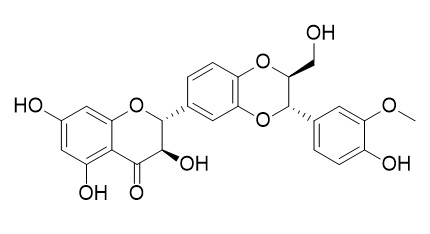Silybin B
Silybin B and silybin A are potent inhibitors of both raloxifene 4'- and 6-glucuronidation in all enzyme systems; they show strong effects on cell growth inhibition and apoptosis induction in human chronic myeloid leukemia K562 cells. Silybin B exhibits 1,1-diphenyl-2-picrylhydrazyl (DPPH) radical scavenging activity.
Inquire / Order:
manager@chemfaces.com
Technical Inquiries:
service@chemfaces.com
Tel:
+86-27-84237783
Fax:
+86-27-84254680
Address:
1 Building, No. 83, CheCheng Rd., Wuhan Economic and Technological Development Zone, Wuhan, Hubei 430056, PRC
Providing storage is as stated on the product vial and the vial is kept tightly sealed, the product can be stored for up to
24 months(2-8C).
Wherever possible, you should prepare and use solutions on the same day. However, if you need to make up stock solutions in advance, we recommend that you store the solution as aliquots in tightly sealed vials at -20C. Generally, these will be useable for up to two weeks. Before use, and prior to opening the vial we recommend that you allow your product to equilibrate to room temperature for at least 1 hour.
Need more advice on solubility, usage and handling? Please email to: service@chemfaces.com
The packaging of the product may have turned upside down during transportation, resulting in the natural compounds adhering to the neck or cap of the vial. take the vial out of its packaging and gently shake to let the compounds fall to the bottom of the vial. for liquid products, centrifuge at 200-500 RPM to gather the liquid at the bottom of the vial. try to avoid loss or contamination during handling.
Arch Toxicol.2024, 98(5):1415-1436.
Heliyon.2023, 9:e21652.
J of Archaeological Science:Reports2024, 53:104298
Pharmaceutics.2022, 14(3):564.
Institut Pasteur Korea2020, doi: 10.21203.
J Chromatogr A.2024, 1714:464544.
Biochem Biophys Res Commun.2018, 505(1):194-200
Hong Kong Baptist University2023, 048330T.
Nutrients.2021, 13(1):254.
Environ Toxicol.2023, 23929.
Related and Featured Products
Nat Prod Commun. 2011 Nov;6(11):1653-6.
A comparison of the diastereoisomers, silybin A and silybin B, on the induction of apoptosis in K562 cells.[Pubmed:
22224281]
Two diastereoisomers of silybin, silybin A and Silybin B, were separated from silymarin by HPLC in our previous study.
METHODS AND RESULTS:
The present study assessed the effects of the diastereoisomers on cell apoptosis, and compared these with their mixture, silybin, in human chronic myeloid leukemia K562 cells. Both isomers showed stronger effects on cell growth inhibition and apoptosis induction than silybin. Compared with Silybin B, silybin A showed higher effects on the production of intracellular reactive oxygen species and Ca2+.
CONCLUSIONS:
These results suggest that silybin A and Silybin B have similar potency on apoptosis induction with different oxidative effects. Antagonistic effects may exist between silybin A and Silybin B, partially through ROS production and Ca2+ increase.
Drug Metab Dispos. 2015 Sep;43(9):1353-9.
Milk Thistle Constituents Inhibit Raloxifene Intestinal Glucuronidation: A Potential Clinically Relevant Natural Product-Drug Interaction.[Pubmed:
26070840 ]
Women at high risk of developing breast cancer are prescribed selective estrogen response modulators, including raloxifene, as chemoprevention. Patients often seek complementary and alternative treatment modalities, including herbal products, to supplement prescribed medications. Milk thistle preparations, including silibinin and silymarin, are top-selling herbal products that may be consumed by women taking raloxifene, which undergoes extensive first-pass glucuronidation in the intestine. Key constituents in milk thistle, flavonolignans, were previously shown to be potent inhibitors of intestinal UDP-glucuronosyl transferases (UGTs), with IC50s ≤ 10 μM. Taken together, milk thistle preparations may perpetrate unwanted interactions with raloxifene.
METHODS AND RESULTS:
The objective of this work was to evaluate the inhibitory effects of individual milk thistle constituents on the intestinal glucuronidation of raloxifene using human intestinal microsomes and human embryonic kidney cell lysates overexpressing UGT1A1, UGT1A8, and UGT1A10, isoforms highly expressed in the intestine that are critical to raloxifene clearance. The flavonolignans silybin A and Silybin B were potent inhibitors of both raloxifene 4'- and 6-glucuronidation in all enzyme systems. The Kis (human intestinal microsomes, 27-66 µM; UGT1A1, 3.2-8.3 µM; UGT1A8, 19-73 µM; and UGT1A10, 65-120 µM) encompassed reported intestinal tissue concentrations (20-310 µM), prompting prediction of clinical interaction risk using a mechanistic static model. Silibinin and silymarin were predicted to increase raloxifene systemic exposure by 4- to 5-fold, indicating high interaction risk that merits further evaluation.
CONCLUSIONS:
This systematic investigation of the potential interaction between a widely used herbal product and chemopreventive agent underscores the importance of understanding natural product-drug interactions in the context of cancer prevention.
Journal of Molecular Catalysis B Enzymatic, 2014, 109:24-30.
Enzymatic oxidative dimerization of silymarin flavonolignans.[Reference:
WebLink]
Dimerization of phenolic compounds can potentially enhance their biological (antioxidant) activity.
METHODS AND RESULTS:
We present here the selective oxidative dimerization of several flavonolignans from Silybum marianum seed extract, namely, silybin A (1a), Silybin B (1b), silychristin (3), and silydianin (4) catalyzed by a laccase from Trametes versicolor. Selective benzylation of C-7 OH group of both silybins ensured the priority of the dimerization reaction, avoiding thus polymerization. C-C homodimers connected via E-rings of silybin A and B and silydianin dimers were successfully isolated after respective debenzylation. On the contrary, dimerization of 7-O-benzyl silychristin afforded a complex, inseparable mixture of the products.
CONCLUSIONS:
All isolated flavonolignan dimers exhibited significantly improved 1,1-diphenyl-2-picrylhydrazyl (DPPH) radical scavenging activity compared to their monomers and, therefore, seem to be promising for further biological studies.



